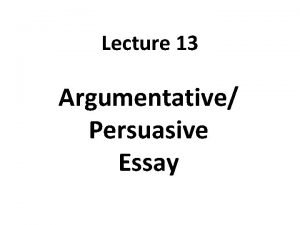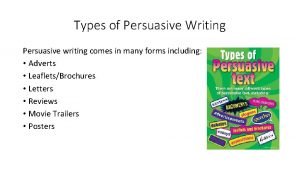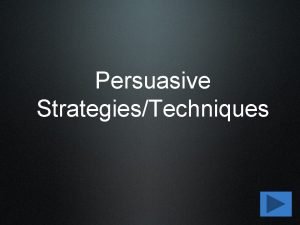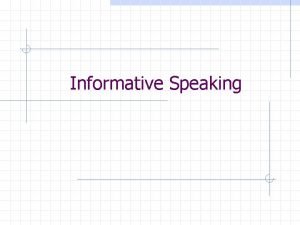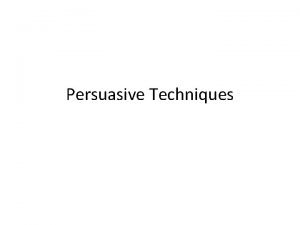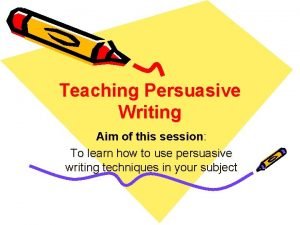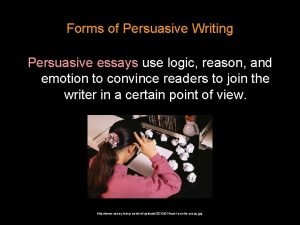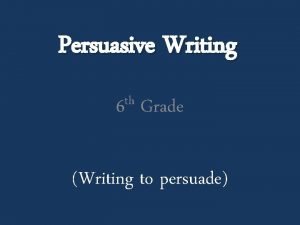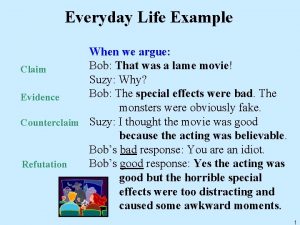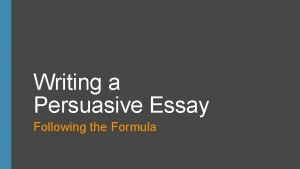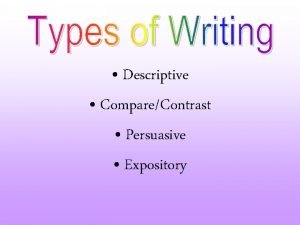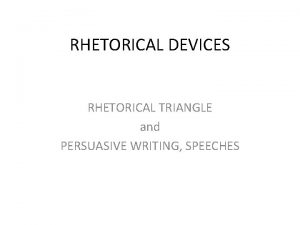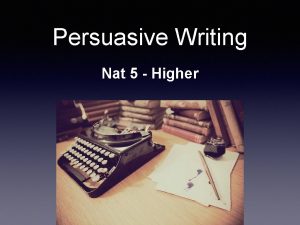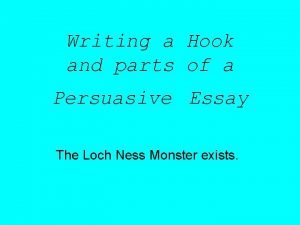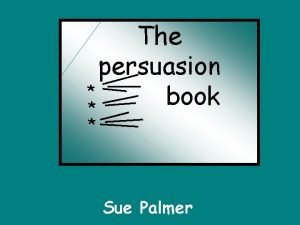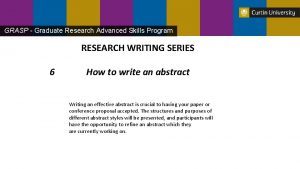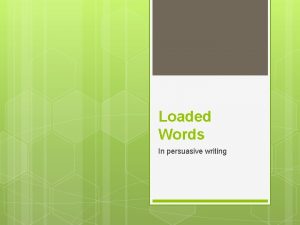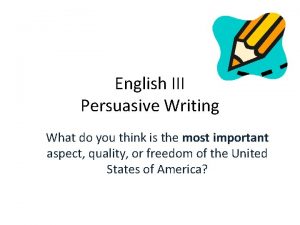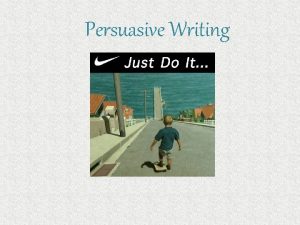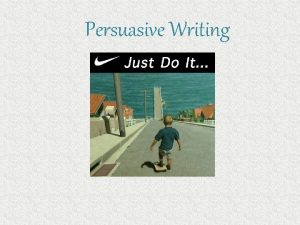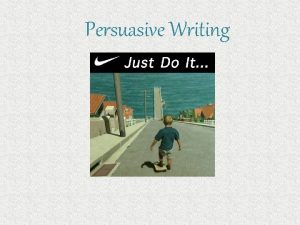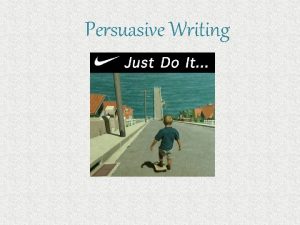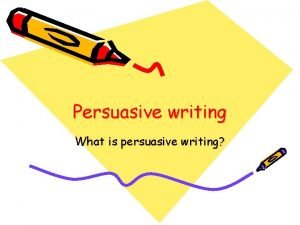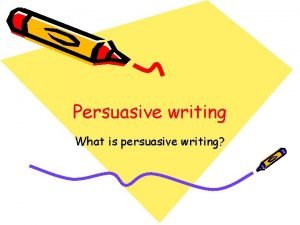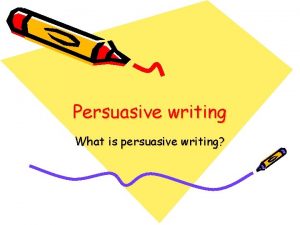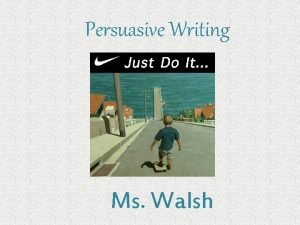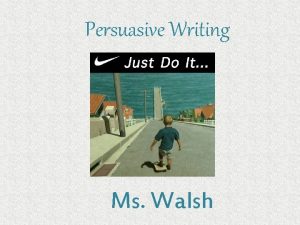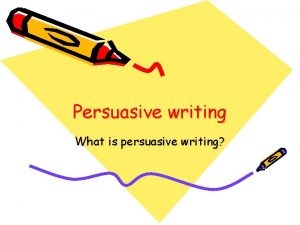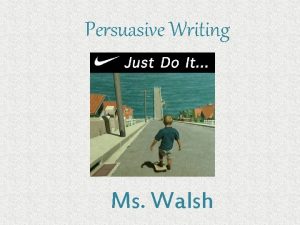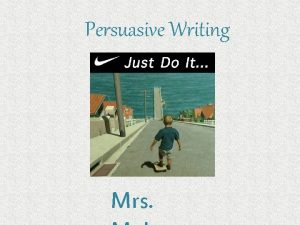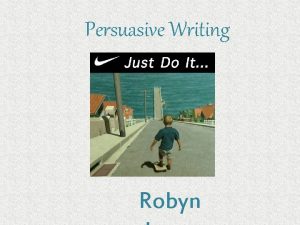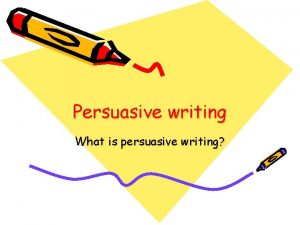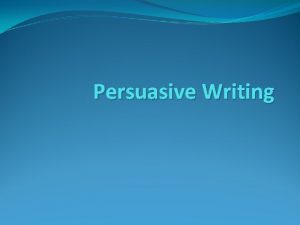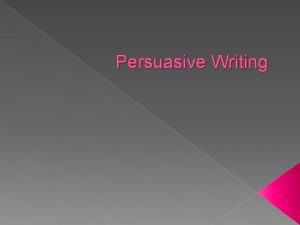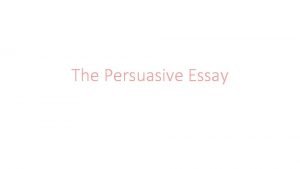Persuasive Writing Persuasive Writing Persuasive writing is writing


























- Slides: 26

Persuasive Writing

Persuasive Writing Persuasive writing is writing that tries to convince a reader to do something or to believe what you believe about a certain topic. It takes a position for or against something.

Persuasive Writing can be used to… Purpose • Support a cause • Urge people to action • Make a change • Prove something wrong Persuasive Statement • “Please support my football team by buying discount coupons. ” • “Vote for Sarah!” • “The principal should let us wear hats. ” • “Cell phones don’t cause brain cancer. ”

Persuasive Writing can be used to… Purpose • Stir up sympathy • Create interest Persuasive Statement • “If you don’t adopt this dog, it could have to live in a shelter. ” • “Better grades get you a better job and more money. ” • Get people to agree with • “I am sure you’ll agree that you Kit. Kat is the best candy bar. ”

Ethos Appeal of the speaker or writer in terms of his / her credibility and experience Presents, directly or indirectly, a profile that sets a stamp of authority on the words used to persuade.

Pathos An appeal to the emotions of the reader or audience. Attempt to induce a particular state of mind in e. g. anger, understanding, sympathy, tolerance Taps into the sentiment or feelings of the audience or readership.

Logos An attempt to persuade the audience (or reader) through sound reasoning. Reliable evidence, e. g. facts, definitions, statistics and other data that appeals to the logic and intelligence of the audience.

Supporting Arguments Ethical Appeal (Ethos)– Is the author’s proposal the right thing to do? Emotional Appeal (Pathos)—Will accepting the author’s proposal make me feel better? Logical Appeal (Logos)—Does the author’s proposal make sense?

Persuasive writing follows a certain format: • INTRODUCTION with a “hook” and thesis statement • BODY where the argument is explained • CONCLUSION where main points are summarized and reviewed and the reader is left with something to think about.

Know Your Audience • Before you start writing, you should know your audience: – Who will read your writing? Who do you need to convince? – The audience may be your friends, your teacher, your parents, your principal, the readers of a newspaper or the President of the United States! – Will you be graded? On What? – Should you be casual or professional?

Pick a side! • The writer must clearly state his/her position and stay with that position. Pick a side! • Generally, the position is stated in the opening paragraph or introduction.

Do Your Research In order to convince the reader you need more than just an opinion; you need facts or examples to back your opinion. So, be sure to do the research! Walsh Publishing Co. 2009

MAKE A PLAN, then write! The 6 Paragraph Essay: 1. Introduction/Hook/Thesis 2. Argument 1 with support 3. Argument 2 with support 4. Argument 3 with support 5. Show the counter-argument and make an argument against it 6. Conclusion

DOS and DON’Ts of Persuasive Writing: • Do: • Divide into 5 paragraphs • Have a thesis statement in your introduction • Come up with 3 main points to support your argument— these will be your 3 body paragraphs • Show the “counter argument” • Have a conclusion that has a “clincher statement” • Come up with a catchy title • Don’t : • Don’t begin with “Hello my name is___ and I’m going to write about____” • Don’t use the word “I “ (Instead of “I think we shouldn’t wear uniforms” say “Uniforms shouldn’t be required. ” • Don’t be wishy-washy. Pick a side! • Don’t forget to support your opinions with facts and example s

The Great Introduction… What makes an good introduction? • It grabs or “hooks” the reader’s attention by using one or more of the following strategies: – An anecdote or scenario – A quotation – An interesting fact or statistic – A question • It tells how the writing will be organized. • The author’s position is clearly stated in a thesis statement.

Grabbing Your Audience… Good strategies used in introductions: • Use an Anecdote/ Scenario – The writer provides a personal experience or made-up situation to introduce the position. • Questioning – The writer asks thought-provoking questions to capture the reader’s interest. • Interesting fact or statistic – The writer gives an interesting piece of information to grab the reader’s attention.

Next: Creating a Thesis Statement • A thesis statement is one sentence at the end of your introduction that states your opinion. It needs to be strong. • First, choose 3 main focus points to discuss in your essay. These points will become the focus of three paragraphs in the body of your paper. Let’s use fast food as an example. Fast food…(3 Discussion Points) • rapidly increases weight • causes high blood pressure • leads to sluggishness

Writing the Thesis Statement • Now take your three main focus points and summarize them. Put your completed thesis statement at the end of your first paragraph. THREE MAIN FOCUS POINTS • I believe fast food is harmful because it rapidly increases weight, causes high blood pressure, and leads to lethargy. COMPLETED THESIS STATEMENT • I believe fast food has negative health effects.

A thesis statement is always one sentence that states your assertion (belief) about a topic. A thesis statement usually includes a forecast (brief preview of your arguments). (I believe) __________ because of argument 1, argument 2, and argument 3.

Which is an example of a good thesis statement? 1. I believe we must stop wasting food now! 2. The problem of food waste can easily be solved by implementing three simple steps: reduce, reuse, recycle. 3. If you aren‘t reducing, reusing, and recycling, you should. 4. I believe wasting food is a huge problem. We need to reduce our food waste. For example, make a shopping list before you go to the store, and only buy things you truly need. You shouldn’t buy a gallon of milk if you are only going to drink a quart of it during the week. Who cares if the gallon size is on sale?

Three Supporting Paragraphs: • Use each of the main arguments you used in your introductory paragraph and expand on each giving facts and reasons. • In our example, you would write one paragraph on how fast food increases weight, one paragraph on how it causes high blood pressure and one on how it leads to sluggishness. Walsh Publishing Co. 2009

THE COUNTERARGUMENT • How many of you have been in a discussion with someone and you remember saying, “Yeah, that’s true, but…” This is called a counter-argument. It’s the “other side” of the argument. • You’ll need to tell your reader what the counter -argument is and prove why it shouldn’t matter.

The Other Side of the Story • This is where you should explain why your opposition believes what they believe. • For example: • “A fast food company wouldn’t agree with the points in this essay. They would have lots of reasons why fast food is good. They may say…”it’s convenient” or “It’s fine if eaten in moderation. ” These arguments just don’t hold up when you take all the facts into consideration! Walsh Publishing Co. 2009

Conclude or End Your Essay… What makes an good conclusion? · Last paragraph summarizes your main point. · End using one or more of the following strategies: – Call the reader to action – Anecdote or scenario – Make a Prediction · The last paragraph wraps up the writing and gives the reader something to think about. Walsh Publishing Co. 2009

Review: The Persuasive Essay: • A Catchy Title • Introductory paragraph with a “hook”, three main arguments and a thesis statement. • One paragraph for each of your three arguments. • Address the “counter-argument” • Closing paragraph that re-states your thesis and challenges the reader to think about it. Walsh Publishing Co. 2009

Don’t Forget… • Make sure to read over your work and edit for mechanics and spelling. • Write neatly! • Include detail and great vocabulary. • Follow proper format: Proper heading and skip lines! Walsh Publishing Co. 2009
 Academichelp.net essay
Academichelp.net essay Argumentative essay vs persuasive
Argumentative essay vs persuasive Anzac day persuasive writing
Anzac day persuasive writing Pow tree example
Pow tree example Types of persuasive writing
Types of persuasive writing Persuasive writing strategies
Persuasive writing strategies Batayang kaalaman sa pagsulat
Batayang kaalaman sa pagsulat Informative vs persuasive
Informative vs persuasive What is repetition persuasive technique
What is repetition persuasive technique Stir up sympathy persuasive statement
Stir up sympathy persuasive statement Imagery in persuasive writing
Imagery in persuasive writing Forms of persuasive writing
Forms of persuasive writing Persuasive writing 6th grade
Persuasive writing 6th grade Argumentative and persuasive difference
Argumentative and persuasive difference What is a persuasive essay
What is a persuasive essay Persuasive essay organization
Persuasive essay organization Expository and persuasive
Expository and persuasive Persuasive devices
Persuasive devices Logos definition in literature
Logos definition in literature Persuasive writing images
Persuasive writing images Persuasive writing structure
Persuasive writing structure Persuasive text structure year 7
Persuasive text structure year 7 Hooks for persuasive essays
Hooks for persuasive essays Sue palmer skeleton books
Sue palmer skeleton books Descriptive abstract example
Descriptive abstract example Loaded word
Loaded word Persuasive writing planning sheet
Persuasive writing planning sheet
